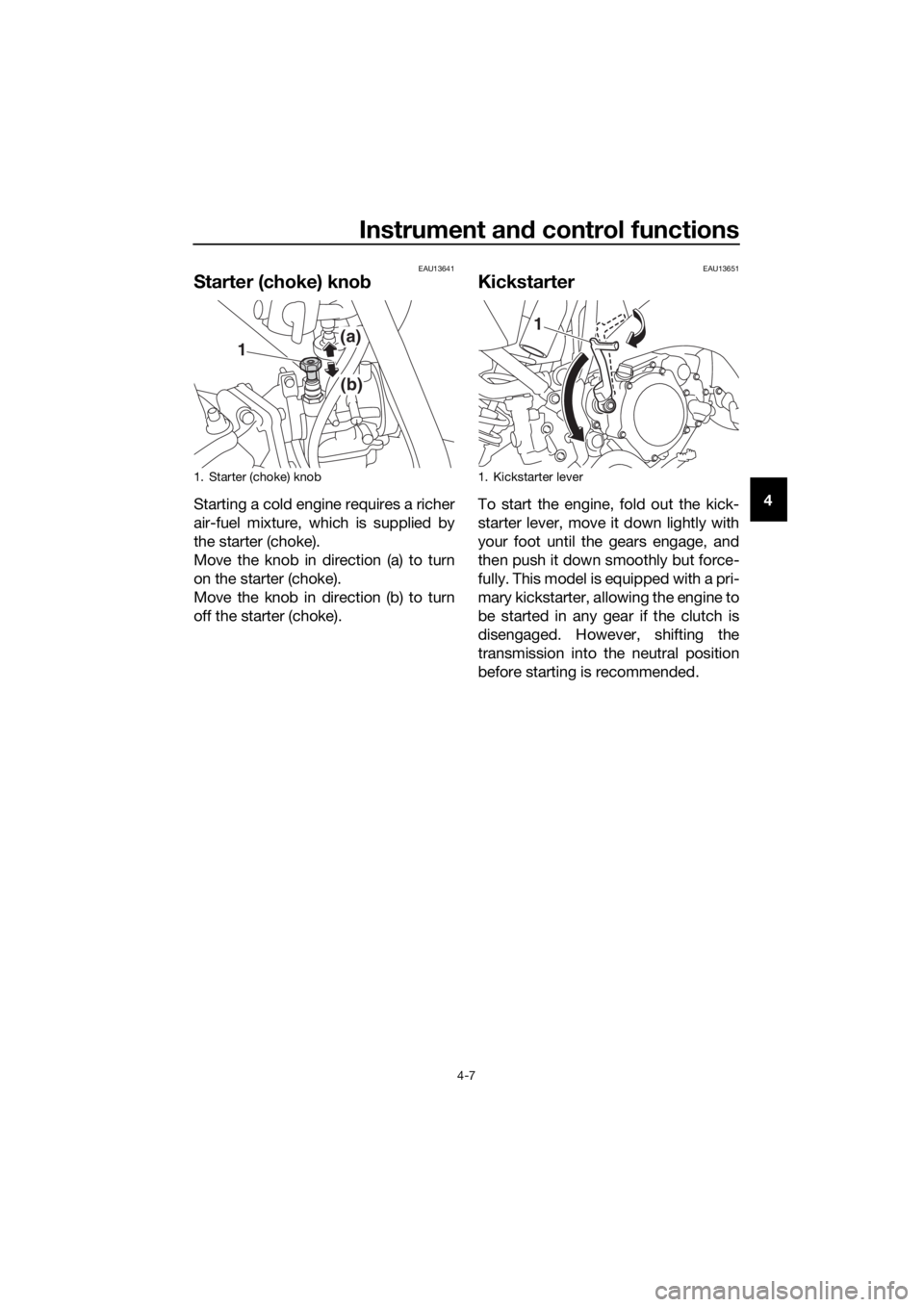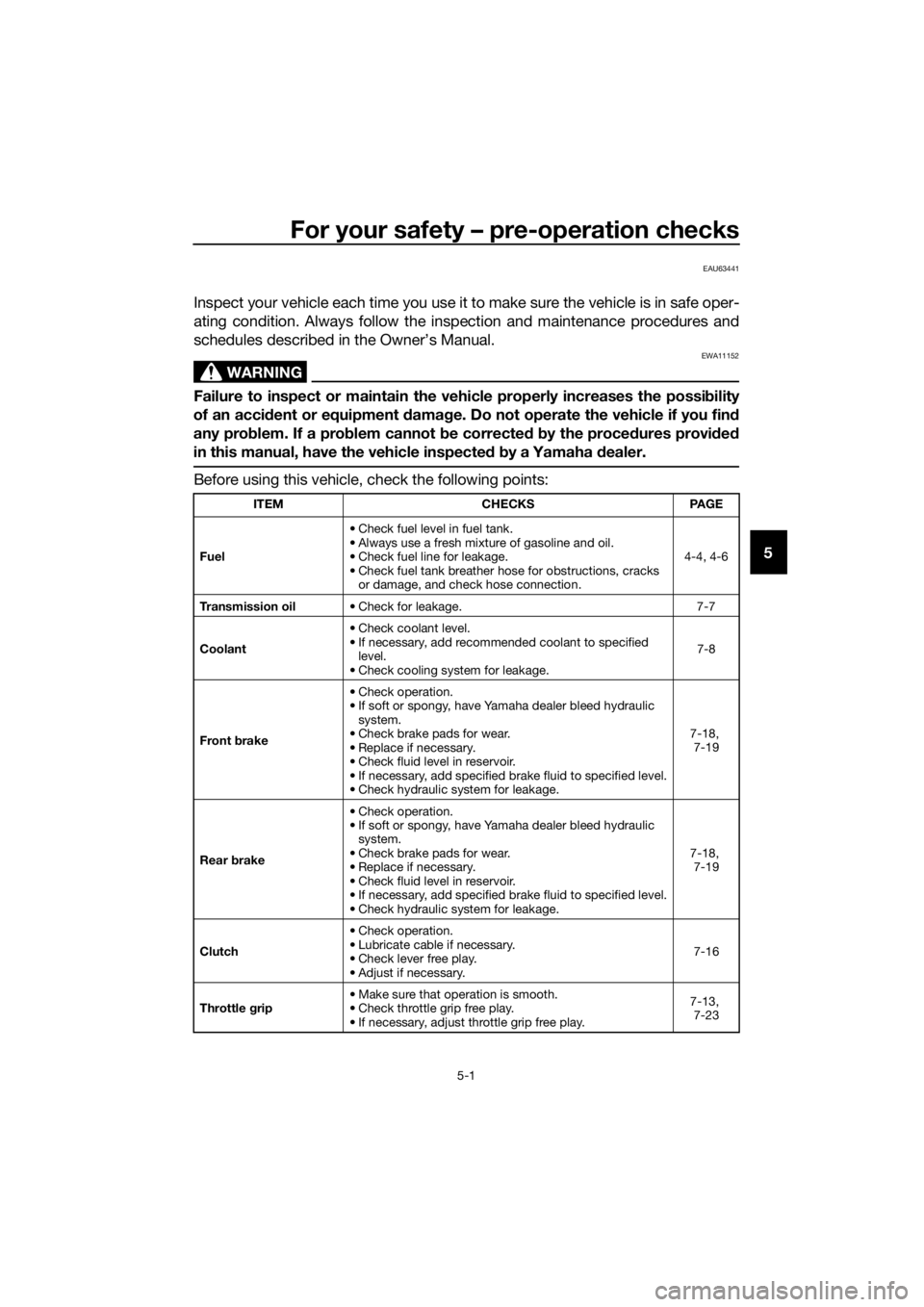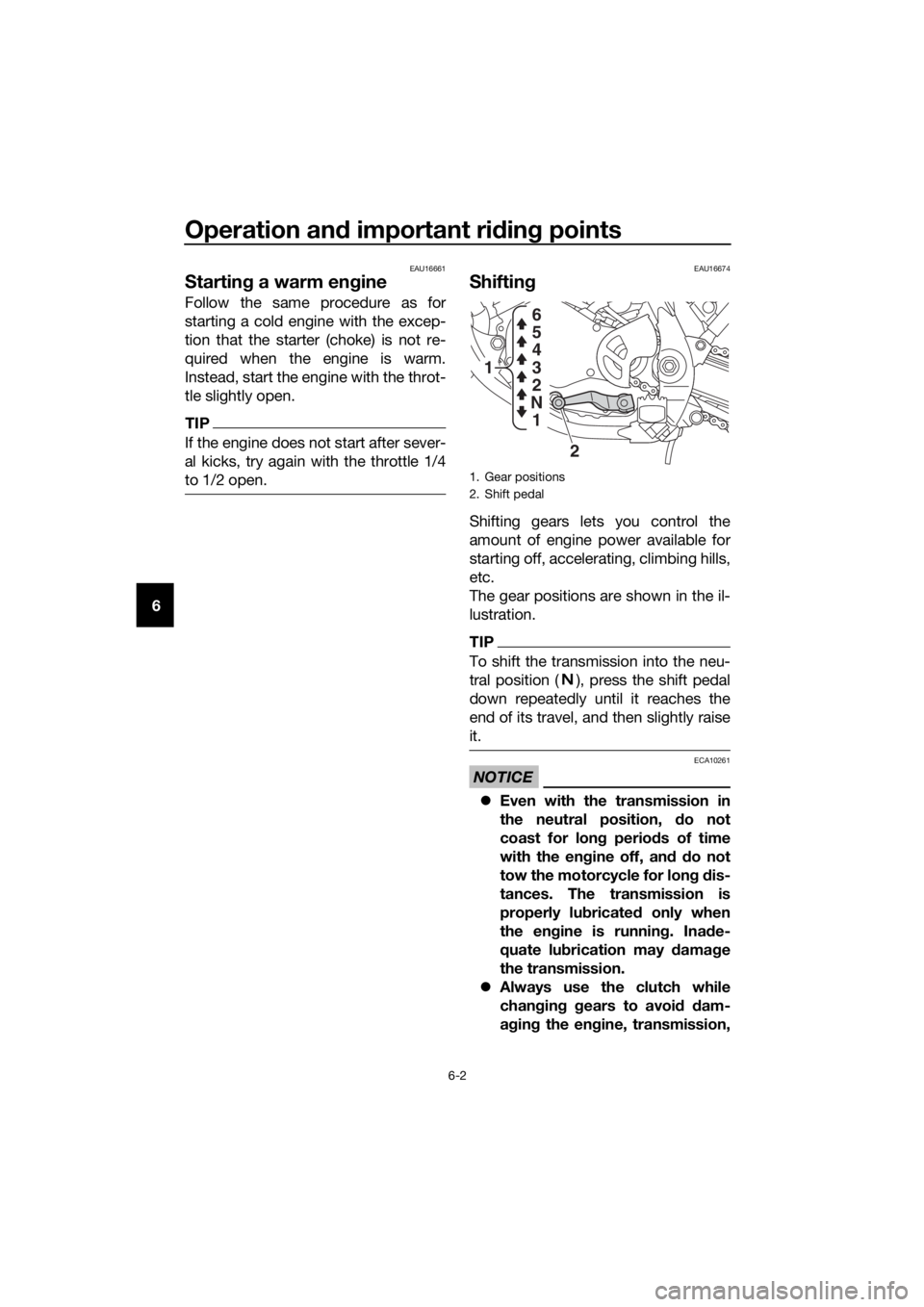2018 YAMAHA YZ65 clutch
[x] Cancel search: clutchPage 8 of 90

Table of contents
Location of important la bels ........... 1-1
Safety information ............................ 2-1
Description ....................................... 3-1
Left view ......................................... 3-1
Right view ....................................... 3-2
Controls and instruments ............... 3-3
Instrument an d control functions ... 4-1
Handlebar switch............................ 4-1
Clutch lever .................................... 4-1
Shift pedal ...................................... 4-2
Brake lever...................................... 4-2
Brake pedal .................................... 4-3
Fuel tank cap .................................. 4-3
Fuel ................................................. 4-4
Fuel tank breather hose.................. 4-6
Fuel cock ........................................ 4-6
Starter (choke) knob ....................... 4-7
Kickstarter ...................................... 4-7
Seat ................................................ 4-8
Adjusting the front fork ................... 4-9
Front fork bleeding ....................... 4-10
Adjusting the shock absorber assembly ................................... 4-11
Removable sidestand ................... 4-15
YPVS system ................................ 4-16
For your safety – pre-operation
checks ............................................... 5-1
Operation an d important ri din g
points ................................................ 6-1
Starting and warming up a cold
engine ......................................... 6-1
Starting a warm engine .................. 6-2
Shifting ........................................... 6-2
Engine break-in .............................. 6-3
Parking ........................................... 6-5
Perio dic maintenance an d
a d justment ........................................ 7-1
Periodic maintenance and lubrication chart .......................... 7-2
Checking the spark plug ................ 7-6 Transmission oil .............................. 7-7
Coolant ............................................ 7-8
Cleaning the air filter element ....... 7-10
Adjusting the carburetor ............... 7-12
Adjusting the engine idling
speed ......................................... 7-12
Adjusting the throttle grip free play ............................................ 7-13
Tires .............................................. 7-14
Spoke wheels ................................ 7-16
Adjusting the clutch lever free play ............................................ 7-16
Checking the brake lever free play ............................................ 7-17
Checking the shift pedal ............... 7-18
Checking the front and rear brake pads ........................................... 7-18
Checking the brake fluid level ....... 7-19
Changing the brake fluid ............... 7-20
Drive chain slack ........................... 7-21
Cleaning and lubricating the drive chain ................................. 7-22
Checking and lubricating the
cables ........................................ 7-23
Checking and lubricating the throttle grip and cable ............... 7-23
Checking and lubricating the brake and clutch levers ............. 7-24
Checking and lubricating the
brake pedal ................................ 7-24
Lubricating the rear suspension.... 7-25
Lubricating the swingarm pivots ... 7-25
Checking the front fork ................. 7-26
Checking the steering ................... 7-26
Checking the wheel bearings ........ 7-27
Supporting the motorcycle ........... 7-27
Front wheel ................................... 7-28
Rear wheel .................................... 7-29
Troubleshooting ............................ 7-30
Troubleshooting charts ................. 7-31
Motorcycle care an d stora ge .......... 8-1
Matte color caution ......................... 8-1
Care................................................. 8-1
Storage............................................ 8-3
UBR880E0.book Page 1 Friday, February 16, 2018 8:32 AM
Page 26 of 90

Description
3-3
3
EAU63401
Controls and instruments
1324
1. Clutch lever (page 4-1)
2. Engine stop switch (page 4-1)
3. Brake lever (page 4-2)
4. Throttle grip (page 7-13)
UBR880E0.book Page 3 Friday, February 16, 2018 8:32 AM
Page 27 of 90

Instrument and control functions
4-1
4
EAU40661
Han dle bar switch
EAU53962En gine stop switch “ENGINE STOP”
Hold this switch pushed until the en-
gine stops.
EAU64023
Clutch lever
The clutch lever is located on the left
side of the handlebar. To disengage
the clutch, pull the lever toward the
handlebar grip. To engage the clutch,
release the lever. The lever should be
pulled rapidly and released slowly for
smooth clutch operation.
The clutch lever is equipped with a
clutch lever position adjusting bolt. Ad-
just the distance between the clutch le-
ver and the handlebar grip as follows. 1. Loosen the locknut.
2. While holding the clutch lever pulled slightly towards the handle-
bar grip, turn the adjusting bolt in
direction (a) to increase the dis-
tance, and in direction (b) to de-
crease it.
3. Tighten the locknut.
1. Engine stop switch “ENGINE STOP”
1. Clutch lever
2. Locknut
3. Clutch lever position adjusting bolt
4. Distance between clutch lever and handle- bar grip
4 2
13
(b)
(a)
UBR880E0.book Page 1 Friday, February 16, 2018 8:32 AM
Page 33 of 90

Instrument and control functions
4-7
4
EAU13641
Starter (choke) knob
Starting a cold engine requires a richer
air-fuel mixture, which is supplied by
the starter (choke).
Move the knob in direction (a) to turn
on the starter (choke).
Move the knob in direction (b) to turn
off the starter (choke).
EAU13651
Kickstarter
To start the engine, fold out the kick-
starter lever, move it down lightly with
your foot until the gears engage, and
then push it down smoothly but force-
fully. This model is equipped with a pri-
mary kickstarter, allowing the engine to
be started in any gear if the clutch is
disengaged. However, shifting the
transmission into the neutral position
before starting is recommended.
1. Starter (choke) knob
1(a)
(b)
1. Kickstarter lever
1
UBR880E0.book Page 7 Friday, February 16, 2018 8:32 AM
Page 43 of 90

For your safety – pre-operation checks
5-1
5
EAU63441
Inspect your vehicle each time you use it to make sure the vehicle is in safe oper-
ating condition. Always follow the inspection and maintenance procedures and
schedules described in the Owner’s Manual.
WARNING
EWA11152
Failure to inspect or maintain the vehicle properly increases the possibility
of an acci dent or equipment d amage. Do not operate the vehicle if you fin d
any prob lem. If a pro blem cannot be corrected b y the proce dures provi ded
in this manual, have the vehicle inspecte d b y a Yamaha d ealer.
Before using this vehicle, check the following points:
ITEM CHECKSPAGE
Fuel • Check fuel level in fuel tank.
• Always use a fresh mixture of gasoline and oil.
• Check fuel line for leakage.
• Check fuel tank breather hose for obstructions, cracks
or damage, and check hose connection. 4-4, 4-6
Tr a n s m i s s i o n o i l • Check for leakage. 7-7
Coolant • Check coolant level.
• If necessary, add recommended coolant to specified
level.
• Check cooling system for leakage. 7-8
Front brake • Check operation.
• If soft or spongy, have Yamaha dealer bleed hydraulic
system.
• Check brake pads for wear.
• Replace if necessary.
• Check fluid level in reservoir.
• If necessary, add specified brake fluid to specified level.
• Check hydraulic system for leakage. 7-18,
7-19
Rear brake • Check operation.
• If soft or spongy, have Yamaha dealer bleed hydraulic
system.
• Check brake pads for wear.
• Replace if necessary.
• Check fluid level in reservoir.
• If necessary, add specified brake fluid to specified level.
• Check hydraulic system for leakage. 7-18,
7-19
Clutch • Check operation.
• Lubricate cable if necessary.
• Check lever free play.
• Adjust if necessary. 7-16
Throttle g rip • Make sure that operation is smooth.
• Check throttle grip free play.
• If necessary, adjust throttle grip free play. 7-13,
7-23
UBR880E0.book Page 1 Friday, February 16, 2018 8:32 AM
Page 44 of 90

For your safety – pre-operation checks
5-2
5
Drive chain• Check chain slack.
• Adjust if necessary.
• Check chain condition.
• Lubricate if necessary. 7-21,
7-22
Drive sprocket • Check the drive sprocket nut torque.
• Tighten if necessary.
—
Wheels and tires •Check for damage.
• Check tire condition and tread depth.
• Check air pressure.
• Correct if necessary.
• Check for loose spokes and tighten if necessary. 7-14,
7-16
Shift pedal • Make sure that operation is smooth.
• Check the shift pedal bolt torque.
• Correct if necessary. 7-18
Brake pedal • Make sure that operation is smooth.
• Lubricate pedal pivoting point if necessary. 7-24
Brake and clutch le-
vers • Make sure that operation is smooth.
• Lubricate lever pivoting points if necessary.
7-24
Steering • Check that the handlebar can be turned smoothly and
has no excessive play. 7-26
Front fork and rear
shock absorber as-
sembly • Check that they operate smoothly and there is no oil
leakage. 4-9,
4-10,
4-11, 7-26
Chassis fasteners • Make sure that all nuts, bolts and screws are properly
tightened.
• Check all cotter pins for damage and correct install- ment.
• Tighten or replace if necessary. —
Moving parts and ca-
bles • Check the control cables for damage.
• Check that the control cables move smoothly.
• Check that the control cables are not caught when the
handlebars are turned or when the front forks travel up
and down.
• Lubricate moving parts and cables if necessary. 7-23,
7-24,
7-25, 7-25
Exhaust system • Check that the exhaust pipe and muffler are tightly
mounted and have no cracks.
• Check for leakage. —
Engine stop switch • Check operation. 4-1
Ignition system • Check that all leads and cables are properly connected. 7-6
ITEM
CHECKSPAGE
UBR880E0.book Page 2 Friday, April 6, 2018 11:11 AM
Page 46 of 90

Operation and important rid ing points
6-2
6
EAU16661
Startin g a warm en gine
Follow the same procedure as for
starting a cold engine with the excep-
tion that the starter (choke) is not re-
quired when the engine is warm.
Instead, start the engine with the throt-
tle slightly open.
TIP
If the engine does not start after sever-
al kicks, try again with the throttle 1/4
to 1/2 open.
EAU16674
Shiftin g
Shifting gears lets you control the
amount of engine power available for
starting off, accelerating, climbing hills,
etc.
The gear positions are shown in the il-
lustration.
TIP
To shift the transmission into the neu-
tral position ( ), press the shift pedal
down repeatedly until it reaches the
end of its travel, and then slightly raise
it.
NOTICE
ECA10261
Even with the transmission in
the neutral position, d o not
coast for lon g period s of time
with the en gine off, an d d o not
tow the motorcycle for lon g d is-
tances. The transmission is
properly lu bricated only when
the en gine is runnin g. Ina de-
quate lu brication may damag e
the transmission.
Always use the clutch while
chan gin g g ears to avoi d d am-
a g in g the en gine, transmission,
1. Gear positions
2. Shift pedal
2
1
1
N 2 3
4
5
6
UBR880E0.book Page 2 Friday, February 16, 2018 8:32 AM
Page 47 of 90

Operation and important ri din g points
6-3
6
an
d d rive train, which are not
d esi gne d to withstan d the
shock of force d shifting .
EAU16691To start out an d accelerate
1. Pull the clutch lever to disengage the clutch.
2. Shift the transmission into first gear.
3. Open the throttle gradually and si- multaneously release the clutch
lever slowly.
4. Once the motorcycle has reached a speed high enough to change
gears, close the throttle, and at the
same time, quickly pull the clutch
lever in.
5. Shift the transmission into second gear. (Make sure not to shift the
transmission into the neutral posi-
tion.)
6. Open the throttle halfway and gradually release the clutch lever.
7. Follow the same procedure when
shifting to the next gear.
EAU16711To decelerate
1. Close the throttle and apply both the front and the rear brakes to
slow the motorcycle.
2. Downshift through the gears and shift the transmission into the neu-
tral position when the motorcycle
is almost completely stopped.
EAU41506
Engine break-in
WARNING
EWA10322
Failure to properly maintain the vehi-
cle or performin g maintenance ac-
tivities incorrectly may increase
your risk of injury or death durin g
service or while usin g the vehicle. If
you are not familiar with vehicle ser-
vice, have a Yamaha d ealer perform
service.
TIP
Before starting the engine for the first
time, the air filter must be lubricated.
(See page 7-10.)
En gine break-in proce dure
1. Fill the fuel tank with a break-in oil- fuel mixture as follows.
2. Start and warm up the engine. Check the operation of the con-
trols and the engine stop switch.
(See page 4-1.)
3. Operate the motorcycle in the low- er gears at moderate throttle
openings for 5 to 8 minutes. Stop
the engine and check the spark
plug condition (see page 7-6); it
will show a rich condition during
break-in.
4. Allow the engine to cool. Restart the engine and operate the motor-
cycle as in the step above for 5
minutes. Then, very briefly shift to
Recommen ded 2-stroke en gine oil:
YAMALUBE 2R
Mixin g ratio ( gasoline to oil):
15:1
UBR880E0.book Page 3 Friday, February 16, 2018 8:32 AM